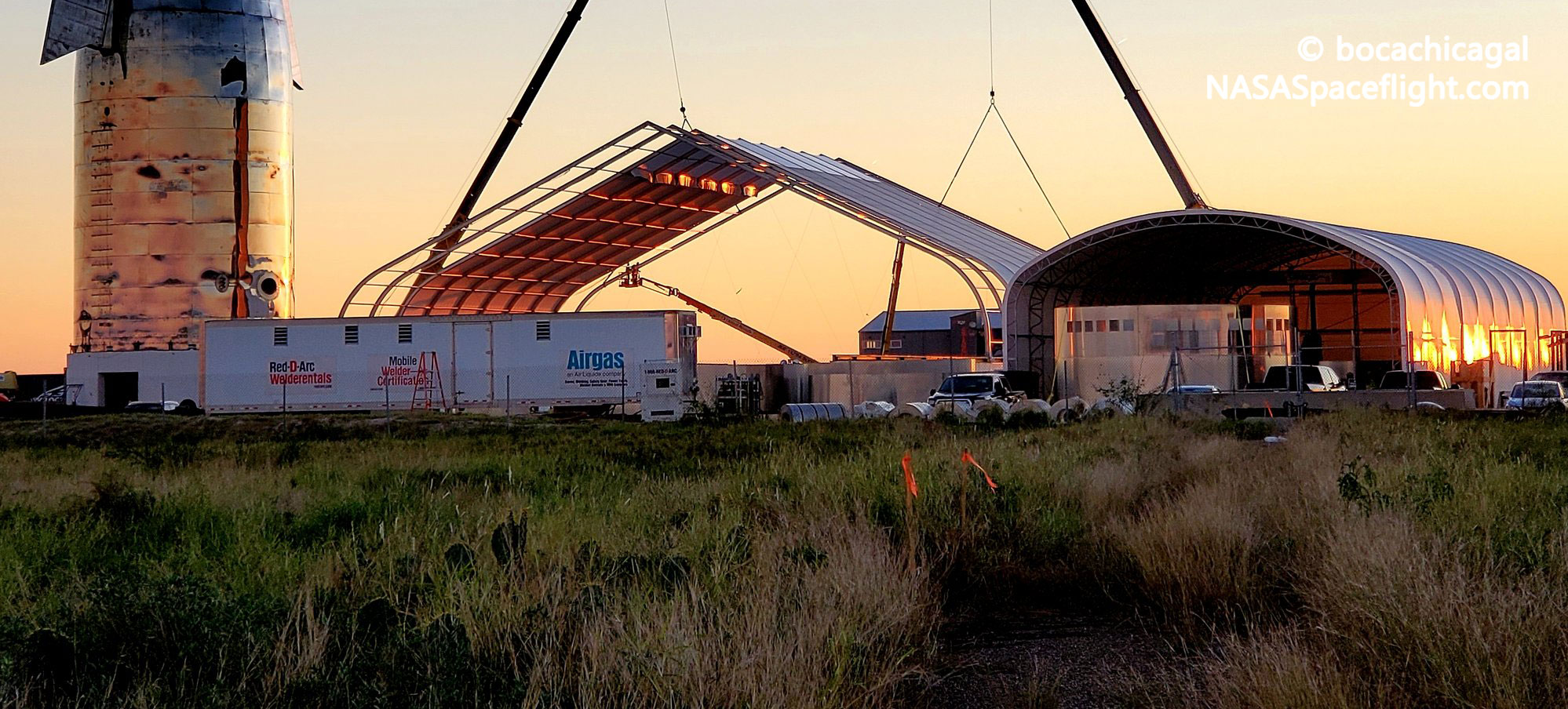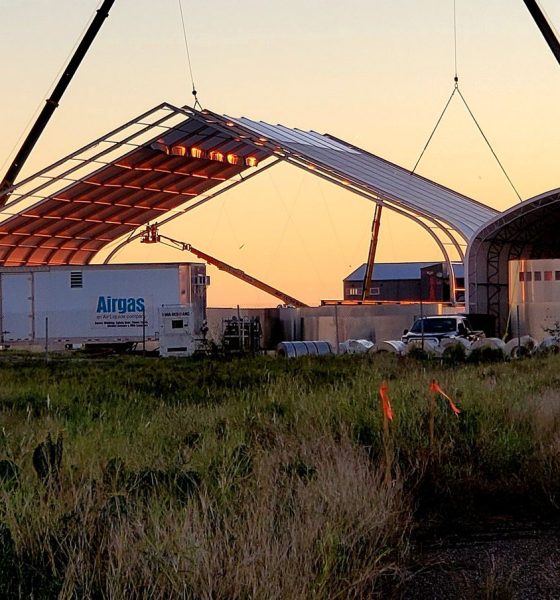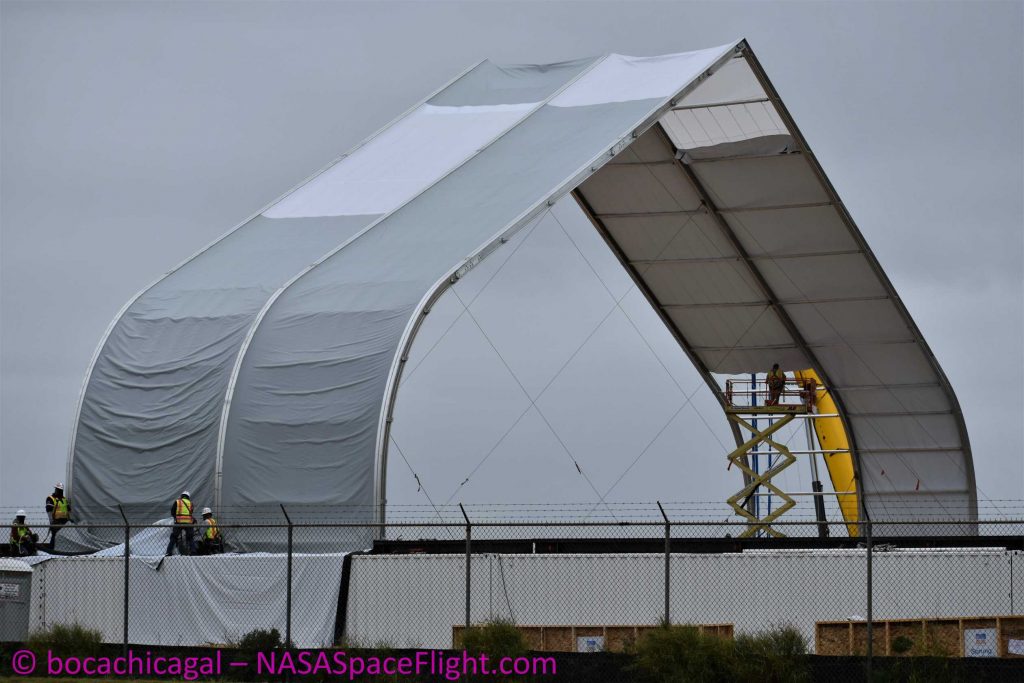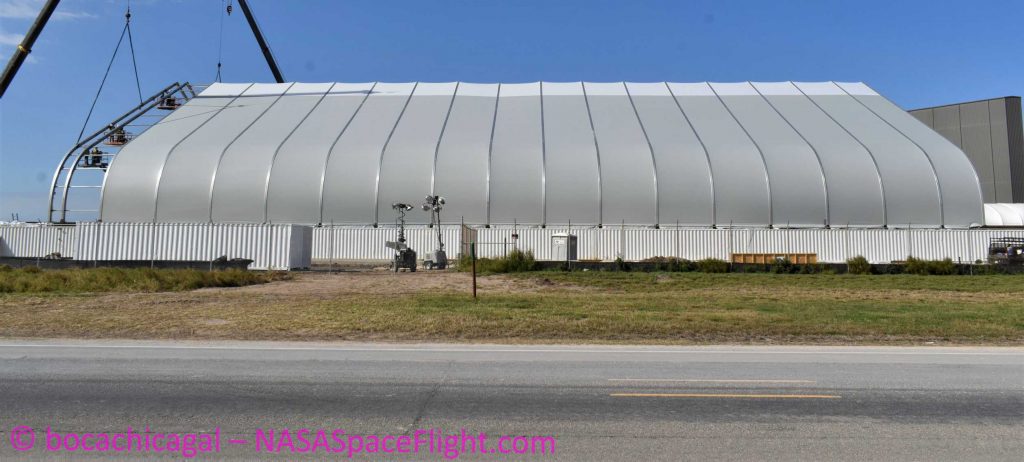

News
SpaceX borrows Tesla's tent factory strategy for new Starship production HQ
Confirmed yesterday morning by CEO Elon Musk, SpaceX has copied Tesla’s approach to factory expansion and is building a giant tent to upgrade its South Texas Starship production facilities.
A big step towards more traditional aerospace-style manufacturing facilities, SpaceX has contracted the same company used by Tesla to create a fourth general assembly line (GA4) in a giant tent outside its Fremont, CA factory in 2018. Instead of Model 3s, however, Sprung Instant Structures (Sprung for short) is rapidly raising a large tent that will eventually allow SpaceX to fabricate and weld more Starship parts and sections in an enclosed environment, an improvement from the current practice of building prototypes out in the harsh environment of coastal Texas.
In typical fashion, Musk believes that the new enclosed production facilities – just a collection of shipping crates as of December 18th – could be ready to begin manufacturing Starship parts as early as next month, and the progress Sprung has made makes it unusually hard to fault his optimism.
Likely taken in mid-December, aerial photos taken by pilot and photographer Sam Sun help sketch out a rough view of the prospective Starship factory. SpaceX appears to have almost entirely foregone a concrete foundation for the new tent, instead opting for lines of steel shipping containers that likely add a bit of height at the cost of structural stability.
.@BocaChicaGal covers the work at these sites extensively, but here's a peek over the fence 😉 pic.twitter.com/0eDJp2agqr— Sam Sun (@BirdsNSpace) December 29, 2019
According to figures printed right on one of Sprung Structures’ many shipments of materials, the initial building will measure approximately 45 meters (150 ft) wide, 77 meters (255 ft) long, and 18 meters (60 ft) tall. While Tesla’s GA4 tent is the same width and (mostly) height, it’s an impressive 280 meters (915 ft) long – almost four times bigger than SpaceX’s newest Boca Chica addition.
While the shipping container foundation is definitely a bit of a risk a mile from the Gulf of Mexico, it does mean that SpaceX might actually be able to move the shell of its new Starship factory if the need arises. SpaceX is in the midst of expanding its Boca Chica lots, potentially giving the company a lot more space to grow its enclosed factory down the road. The simplest possible expansion available would basically double the length of the existing structure, making it more like 150-180 meters (500-600 ft) long.


Regardless, even the current 150′ x 255′ enclosure will end up offering more than 38,000 ft² (3500 m²) of factory space once finished. Depending on what its primary purpose is, SpaceX could probably fit 5-8 stacks of 5-6 rings each (10-11m tall) down the center of the tent, with room for maybe 10-24 additional stacks of 2-3+ rings (3.5-5m tall) in the space remaining. The middle line of hypothetical rings could produce the entire barrel section of 1-2 Starships simultaneously, leaving perhaps 3-4 large sections to be welded together out in the elements or at SpaceX’s new wedge-shaped windbreak.
Of course, the facility will likely end up being mixed-use, potentially offering enough space to simultaneous fabricate all subsections of a single Starship prototype before they are assembled elsewhere.
Ultimately, Sprung is now in the process of installing a large quantity of insulation inside the tent’s walls, indicating that SpaceX’s South Texas welding crew may soon be blessed with a climate-controlled work environment. Meanwhile, SpaceX CEO Elon Musk believes that Boca Chica’s new tent could be complete and ready to begin building Starship hardware as soon as January 2020, while he says that the next Starship prototype – now known as Starship SN01 (serial number 01) – could be ready for flight testing just one or two months after that.
Check out Teslarati’s Marketplace! We offer Tesla accessories, including for the Tesla Cybertruck and Tesla Model 3.

News
Tesla (TSLA) receives “Buy” rating and $551 PT from Canaccord Genuity
He also maintained a “Buy” rating for TSLA stock over the company’s improving long-term outlook, which is driven by autonomy and robotics.

Canaccord Genuity analyst George Gianarikas raised his Tesla (NASDAQ:TSLA) price target from $482 to $551. He also maintained a “Buy” rating for TSLA stock over the company’s improving long-term outlook, which is driven by autonomy and robotics.
The analyst’s updated note
Gianarikas lowered his 4Q25 delivery estimates but pointed to several positive factors in the Tesla story. He noted that EV adoption in emerging markets is gaining pace, and progress in FSD and the Robotaxi rollout in 2026 represent major upside drivers. Further progress in the Optimus program next year could also add more momentum for the electric vehicle maker.
“Overall, yes, 4Q25 delivery expectations are being revised lower. However, the reset in the US EV market is laying the groundwork for a more durable and attractive long-term demand environment.
“At the same time, EV penetration in emerging markets is accelerating, reinforcing Tesla’s potential multi‑year growth runway beyond the US. Global progress in FSD and the anticipated rollout of a larger robotaxi fleet in 2026 are increasingly important components of the Tesla equity story and could provide sentiment tailwinds,” the analyst wrote.
Tesla’s busy 2026
The upcoming year would be a busy one for Tesla, considering the company’s plans and targets. The autonomous two-seat Cybercab has been confirmed to start production sometime in Q2 2026, as per Elon Musk during the 2025 Annual Shareholder Meeting.
Apart from this, Tesla is also expected to unveil the next-generation Roadster on April 1, 2026. Tesla is also expected to start high-volume production of the Tesla Semi in Nevada next year.
Apart from vehicle launches, Tesla has expressed its intentions to significantly ramp the rollout of FSD to several regions worldwide, such as Europe. Plans are also underway to launch more Robotaxi networks in several more key areas across the United States.
News
Waymo sues Santa Monica over order to halt overnight charging sessions
In its complaint, Waymo argued that its self-driving cars’ operations do not constitute a public nuisance, and compliance with the city’s order would cause the company irreparable harm.

Waymo has filed a lawsuit against the City of Santa Monica in Los Angeles County Superior Court, seeking to block an order that requires the company to cease overnight charging at two facilities.
In its complaint, Waymo argued that its self-driving cars’ operations do not constitute a public nuisance, and compliance with the city’s order would cause the company irreparable harm.
Nuisance claims
As noted in a report from the Los Angeles Times, Waymo’s two charging sites at Euclid Street and Broadway have operated for about a year, supporting the company’s growing fleet with round-the-clock activity. Unfortunately, this has also resulted in residents in the area reportedly being unable to sleep due to incessant beeping from self-driving taxis that are moving in and out of the charging stations around the clock.
Frustrated residents have protested against the Waymos by blocking the vehicles’ paths, placing cones, and “stacking” cars to create backups. This has also resulted in multiple calls to the police.
Last month, the city issued an order to Waymo and its charging partner, Voltera, to cease overnight operations at the charging locations, stating that the self-driving vehicles’ activities at night were a public nuisance. A December 15 meeting yielded no agreement on mitigations like software rerouting. Waymo proposed changes, but the city reportedly insisted that nothing would satisfy the irate residents.
“We are disappointed that the City has chosen an adversarial path over a collaborative one. The City’s position has been to insist that no actions taken or proposed by Waymo would satisfy the complaining neighbors and therefore must be deemed insufficient,” a Waymo spokesperson stated.
Waymo pushes back
In its legal complaint, Waymo stated that its “activities at the Broadway Facilities do not constitute a public nuisance.” The company also noted that it “faces imminent and irreparable harm to its operations, employees, and customers” from the city’s order. The suit also stated that the city was fully aware that the Voltera charging sites would be operating around the clock to support Waymo’s self-driving taxis.
The company highlighted over one million trips in Santa Monica since launch, with more than 50,000 rides starting or ending there in November alone. Waymo also criticized the city for adopting a contentious strategy against businesses.
“The City of Santa Monica’s recent actions are inconsistent with its stated goal of attracting investment. At a time when the City faces a serious fiscal crisis, officials are choosing to obstruct properly permitted investment rather than fostering a ‘ready for business’ environment,” Waymo stated.
News
Tesla FSD v14.2.2 is getting rave reviews from drivers
So far, early testers have reported buttery-smooth drives with confident performance, even at night or on twisty roads.

Tesla Full Self-Driving (Supervised) v14.2.2 is receiving positive reviews from owners, with several drivers praising the build’s lack of hesitation during lane changes and its smoother decision-making, among others.
The update, which started rolling out on Monday, also adds features like dynamic arrival pin adjustment. So far, early testers have reported buttery-smooth drives with confident performance, even at night or on twisty roads.
Owners highlight major improvements
Longtime Tesla owner and FSD user @BLKMDL3 shared a detailed 10-hour impression of FSD v14.2.2, noting that the system exhibited “zero lane change hesitation” and “extremely refined” lane choices. He praised Mad Max mode’s performance, stellar parking in locations including ticket dispensers, and impressive canyon runs even in dark conditions.
Fellow FSD user Dan Burkland reported an hour of FSD v14.2.2’s nighttime driving with “zero hesitations” and “buttery smooth” confidence reminiscent of Robotaxi rides in areas such as Austin, Texas. Veteran FSD user Whole Mars Catalog also demonstrated voice navigation via Grok, while Tesla owner Devin Olsen completed a nearly two-hour drive with FSD v14.2.2 in heavy traffic and rain with strong performance.
Closer to unsupervised
FSD has been receiving rave reviews, even from Tesla’s competitors. Xpeng CEO He Xiaopeng, for one, offered fresh praise for FSD v14.2 after visiting Silicon Valley. Following extended test drives of Tesla vehicles running the latest FSD software, He stated that the system has made major strides, reinforcing his view that Tesla’s approach to autonomy is indeed the proper path towards autonomy.
According to He, Tesla’s FSD has evolved from a smooth Level 2 advanced driver assistance system into what he described as a “near-Level 4” experience in terms of capabilities. While acknowledging that areas of improvement are still present, the Xpeng CEO stated that FSD’s current iteration significantly surpasses last year’s capabilities. He also reiterated his belief that Tesla’s strategy of using the same autonomous software and hardware architecture across private vehicles and robotaxis is the right long-term approach, as it would allow users to bypass intermediate autonomy stages and move closer to Level 4 functionality.








